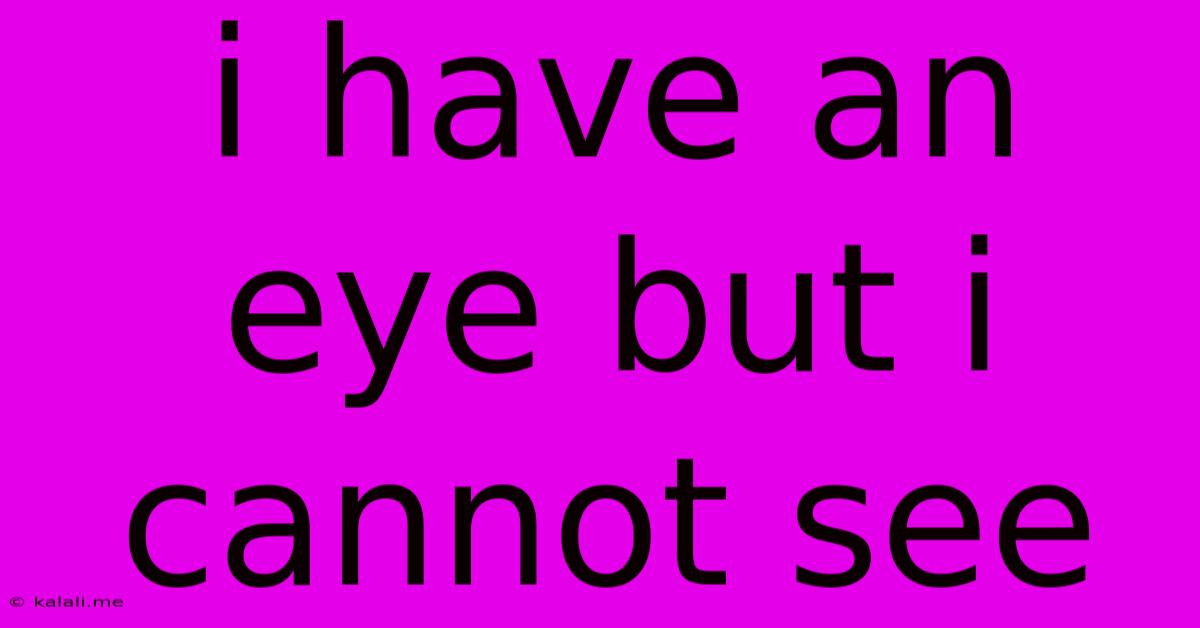I Have An Eye But I Cannot See
Kalali
May 21, 2025 · 3 min read

Table of Contents
I Have an Eye But I Cannot See: Unraveling the Riddle and Exploring its Meanings
This intriguing phrase, "I have an eye but cannot see," is a classic riddle that sparks curiosity and invites multiple interpretations. It's a great example of figurative language, prompting us to think beyond the literal meaning. This article will delve into the various possible meanings, explore its symbolic representation, and even suggest ways you can use this phrase in your creative writing.
What's the answer to the riddle? The most common answer is a needle. A needle has an eye (the hole through which the thread is passed), but it obviously cannot see. This simple answer, however, opens the door to a wealth of deeper, more metaphorical interpretations.
Beyond the Needle: Deeper Meanings and Symbolism
The phrase transcends its literal solution, offering a rich tapestry of symbolic meanings:
-
Lack of Insight or Understanding: The "eye" can represent perception, understanding, or wisdom. The inability to "see" symbolizes a lack of insight, a failure to grasp a situation, or a blindness to the truth. This could be applied to various situations, from missing obvious clues in a mystery to failing to recognize personal flaws.
-
Superficial Observation: Someone might possess the tools (the "eye") for keen observation, but lack the deeper understanding or critical thinking necessary to truly "see" the bigger picture. They might gather information but fail to interpret it meaningfully.
-
Obstructed Vision: The inability to "see" could be a metaphorical representation of obstacles hindering one's perception. This could include prejudice, misinformation, or personal biases that distort reality.
-
Loss of Innocence or Naiveté: The "eye" might represent a once-clear vision of the world, now clouded by experience or disillusionment. The inability to "see" reflects a loss of innocence or a disillusioned perspective.
-
Figurative Blindness: This could describe a situation where someone is aware of something but chooses to ignore it, effectively rendering themselves "blind." This relates to the concept of willful ignorance.
Using the Phrase in Creative Writing
The phrase's evocative nature makes it a valuable tool for writers. Consider these applications:
-
Titles: "I Have an Eye But Cannot See" could serve as a compelling title for a short story, poem, or even a novel, immediately grabbing the reader's attention.
-
Metaphors and Similes: Use the phrase or its components as a metaphor or simile to describe characters, situations, or themes. For example: "He had the eye of a detective, but he could not see the killer's true motive."
-
Symbolism: Incorporate the phrase's symbolic meanings into your narrative to add layers of depth and meaning. A character's inability to "see" could represent a central conflict or a crucial turning point in the story.
-
Riddle or Puzzle: Use the phrase as a riddle or puzzle element to add intrigue and challenge your readers.
In conclusion, "I have an eye but cannot see" is more than just a simple riddle. Its multiple interpretations and rich symbolism make it a powerful tool for expressing complex ideas and adding depth to creative writing. Whether you’re interested in its literal solution or its broader metaphorical significance, this phrase offers ample opportunity for insightful exploration.
Latest Posts
Latest Posts
-
Salesforce Ampscript Evaluate Decimel Greater Than 0
May 23, 2025
-
Adobe Illustator Cant Use Paint Brush
May 23, 2025
-
Can You Point Us To The Right Person
May 23, 2025
-
Dbus Failed Connection 1 61 Is Not Allowed
May 23, 2025
-
Format Usb To Ext3 Mac Os
May 23, 2025
Related Post
Thank you for visiting our website which covers about I Have An Eye But I Cannot See . We hope the information provided has been useful to you. Feel free to contact us if you have any questions or need further assistance. See you next time and don't miss to bookmark.